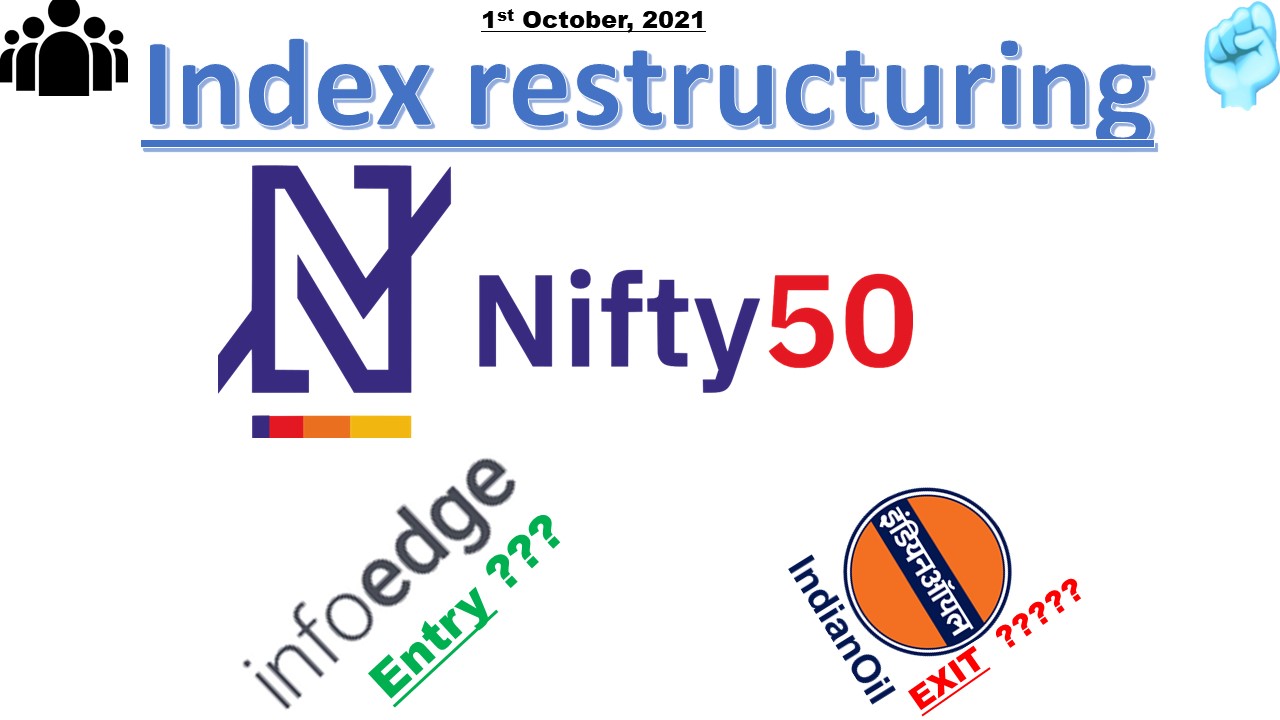Index restructuring explained
Article published as on Tuesday, 24th August, 2021 at 7:00 a.m.
Nifty 50 forward EPS
I am writing this article because nifty has been
surging and there have been many reports where
views/opinions/estimates/predictions are shared justifying the rally, and how
Nifty EPS would increase in a significant way for FY22, FY23 and there
onwards...
(Link
to article, current Nifty EPS at Rs 654.15)
"In my opinion" the actual nifty 50 EPS
would be much lower than anticipated because of the restructuring which happens
every 6 months
Index restructuring
Nifty 50, nifty next 50, nifty 500 and for all
other index restructuring happens every 6 months.
Changes come into effect on the first trading day
after March and September F&O expiry every year.
How is it decided which stocks are going to enter and exit nifty?
Broadly the following criteria is used in the selection,
Stock whose free float market capitalisation has
reduced have higher probability of exiting nifty.
And stocks whose market capitalisation free float market
capitalisation has increased significantly are likely to enter into nifty.
The free float of the new stock shall be at least
1.5 times the lowest free float of the nifty stock.
There are other conditions as well, there is a
detailed procedure outlined here is this link
(Link
to index methodology)
Let’s look at restructuring that have happened
since March 2018 till March 2021
Which constituents were removed and which were
included.
Table on inclusion and exclusion from Nifty 50.
| Exclusions | current P/E ratio | inclusions | current P/E ratio |
March, 2018 | | | | |
| Ambuja Cements ltd | 33.44 | Bajaj Finserv Ltd | 1337.69 |
| Aurobindo Pharma Ltd | 15.18 | Grasim Industries Ltd | 58.06 |
| Bosch Ltd | 46.77 | Titan Company Ltd | 137.88 |
September, 2018 | | | | |
| Lupin | 27.35 | JSW steel | 11.9 |
March, 2019 | | | | |
| HindPetro(HPCL) | 3.63 | Britannia industries Ltd | 54.88 |
September,2019 | | | | |
| Indiabulls housing Finance Ltd | 9.59 | Nestle India ltd | 85.26 |
March,2020 | | | | |
| Yes bank | N/A | Shree Cements Ltd | 36.42 |
September,2020 | | | | |
| Bharti Infratel Ltd | 15.01 | Divis Laboratories Ltd | 63.54 |
| Zee entertainment Enterprises Ltd | 11.78 | SBI life insurance Company Ltd. | 88.16 |
March, 2021 | | | | |
| GAIL | 10.11 | Tata Consumer products Ltd | 113.08 |
As we can see in last 3 years most of the stocks
having Higher P/E ratio have entered nifty and mostly stocks with lower P/E
ratio have exited the nifty.
(In the upcoming restructuring of 31st September
IOC, Coal India are proposed to exit nifty and InfoEdge or Dmart are likely to
enter into the nifty)
The exact details and information will be known for
sure by a public notice at least 7 days before the day of restructuring.
(link
to view restructuring notices)
(P/E based on closing prices as on 23rd
August, 2021)
To conclude …
The point is, we have companies from HDFC group,
Bajaj group which have consistent growth in profits, but this performance is
countered by changing constituents of index, where high P/E stock enter nifty,
their impact is such that no significant growth in Nifty EPS is seen.
Also another point I want to discuss
is that people judge Nifty as undervalued and overvalued based on the P/E
ratio.
For example
P/E range of 12-15 was considered as
being undervalued
And anything above P/E of 28 was
considered overvalued
But we can see that Nifty has been
trading above this level consistently now, and still its price level is
increasing.
(After March 31st,
2021 a change was made, that now consolidated earnings will be considered instead
of standalone earnings, due to this Nifty EPS was boosted and P/E ratio declined)
Few years ago (say 2010 for example)
nifty had stock which traded at cheaper P/E valuation, and today nifty consists
of stock that trade at Higher P/E valuation.
So the same logic of undervaluation
and overvaluation based on P/E range won’t be suitable and applicable in
today’s scenario.
And the current Nifty EPS is Rs 653,
so at the level of 16,500 the P/E Works out to be 25.
So the point highlighted in the
article above are
1) Due to change in index stocks nifty EPS is not
likely to go increase significantly as some of the analyst predict.
2) Valuing nifty based on previously followed P/E
ranges won’t work anymore, as the fundamental composition of the index has
itself changed over the years.
UPDATE:
In
the most recent circular there are no
changes in the Nifty 50 index, but there are several changes for the other
nifty indices, the next changes will
be made on 25th March 2022.
Also
in August it was proposed to include the REIT’s and InVIT’s in the index, but
for the time being this decision is kept on hold.
In
Hang sang Index, index of Hong Kong, the REIT’s and InVIT’s are already
present.
India
will also move toward inclusion of REIT’s and InVIT’s in its index. But first
we need more such instruments and also a higher liquidity.


ConversionConversion EmoticonEmoticon